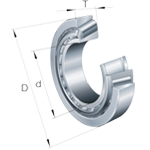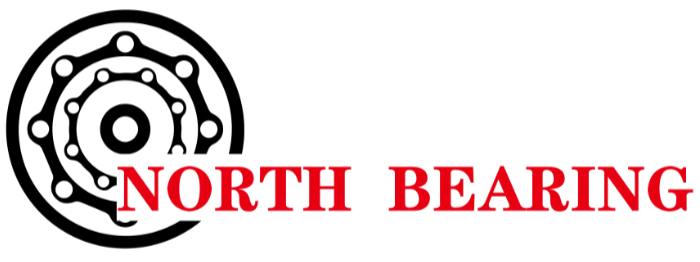
What is Tapered Roller Bearings?
Tapered roller bearings are separable bearings, and both the inner and outer rings of the bearing have tapered raceways. This type of bearing is divided into different structural types such as single-row, double-row and four-row tapered roller bearings according to the number of rows of rollers installed. Single row tapered roller bearings can withstand radial loads and axial loads in one direction. When the bearing is subjected to radial load, an axial component force will be generated, so when another bearing that can withstand axial force in the opposite direction is needed to balance it.
Introduction Edit Broadcast Tapered roller bearings refer to radial thrust rolling bearings whose rolling elements are tapered rollers. There are two kinds of small cone angle and large cone angle. The small taper angle mainly bears the combined radial and axial loads mainly based on the radial load. It is often used in pairs and installed in the opposite direction. The inner and outer races can be installed separately, and the radial and axial clearances can be adjusted during installation and use; The large cone angle mainly bears the combined axial and radial loads mainly based on the axial load. Generally, it is not used to bear the pure axial load alone, but can be used to bear the pure radial load when it is configured in pairs (the ends with the same name are installed opposite to each other).
Tapered roller bearings refer to radial thrust rolling bearings whose rolling elements are tapered rollers. There are two kinds of small cone angle and large cone angle. The small taper angle mainly bears the combined radial and axial loads mainly based on the radial load. It is often used in pairs and installed in the opposite direction. The inner and outer races can be installed separately, and the radial and axial clearances can be adjusted during installation and use; The large cone angle mainly bears the combined axial and radial loads mainly based on the axial load. Generally, it is not used to bear the pure axial load alone, but can be used to bear the pure radial load when it is configured in pairs (the ends with the same name are installed opposite to each other).
Classification of Tapered Roller Bearings
Single row tapered roller bearings have an outer ring, an inner ring assembly of which the inner ring and a set of tapered rollers are enclosed by a basket cage. The outer ring can be separated from the inner ring assembly. According to the ISO tapered roller bearing dimension standard, the outer ring or inner ring assembly of any standard type of tapered roller bearing should be able to achieve international performance with the same type of outer ring or inner ring assembly. exchange. That is to say, the outer ring of the same type must comply with the ISO492 (GB307) regulations in addition to the external dimensions and tolerances, and the cone angle of the inner ring component and the diameter of the component cone must also comply with the relevant regulations for interchangeability. Generally, the taper angle of the outer ring raceway of a single-row tapered roller bearing is between 10° and 19°, which can bear the combined effect of axial load and radial load at the same time. The larger the cone angle, the greater the ability to bear the axial load. Bearings with large taper angle, post code plus B, taper angle between 25°~29°, it can bear large axial load. In addition, single row tapered roller bearings can adjust the size of the clearance during installation. The outer ring (or inner ring) of a double row tapered roller bearing is a single piece. The small end faces of the two inner rings (or outer rings) are similar, and there is a spacer in the middle. The clearance is adjusted by the thickness of the spacer. The thickness of the spacer can also be used to adjust the pee-interference of the double-row tapered roller bearing. Four-row tapered roller bearing, the performance of this type of bearing is basically the same as that of double-row tapered roller bearing, but the radial load is larger than that of double-row tapered roller bearing, and the limit speed is slightly lower. It is mainly used for heavy machinery.
The main uses of Tapered Roller Bearings
Tapered roller bearings mainly bear the combined radial and axial loads mainly in the radial direction. The bearing capacity depends on the raceway angle of the outer ring, and the larger the angle, the greater the bearing capacity. This type of bearing is a separable bearing, which is divided into single-row, double-row and four-row tapered roller bearings according to the number of rows of rolling elements in the bearing. The clearance of single-row tapered roller bearings needs to be adjusted by the user during installation; the clearance of double-row and four-row tapered roller bearings has been given according to the user’s requirements when the product leaves the factory, and does not need to be adjusted by the user. Tapered roller bearings have tapered inner and outer raceways with tapered rollers arranged in between. The projected lines of all conical surfaces meet at the same point on the bearing axis. This design makes tapered roller bearings particularly suitable for combined (radial and axial) loads. The axial load capacity of the bearing is mostly determined by the contact angle α; the larger the α angle, the higher the axial load capacity. The size of the angle is represented by the calculation coefficient e; the larger the value of e, the larger the contact angle, and the greater the applicability of the bearing to bear the axial load. Tapered roller bearings are usually separable, that is, the tapered inner ring assembly consisting of the inner ring with the roller and cage assembly can be installed separately from the tapered outer ring (outer ring). Tapered roller bearings are widely used in automobiles, rolling mills, mining, metallurgy, plastic machinery and other industries.
Model of Tapered Roller Bearings

